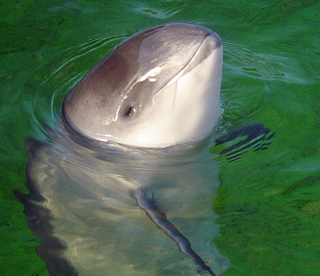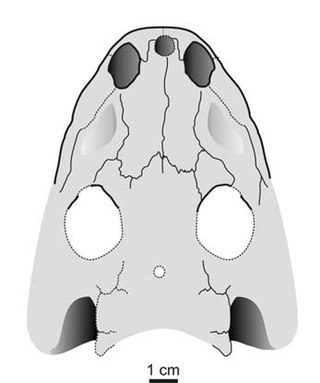
Genus is a taxonomic rank above species and below family as used in the biological classification of living and fossil organisms as well as viruses. In binomial nomenclature, the genus name forms the first part of the binomial species name for each species within the genus.

Phocoena is a genus of porpoises with four extant species.
In biology, a monotypic taxon is a taxonomic group (taxon) that contains only one immediately subordinate taxon. A monotypic species is one that does not include subspecies or smaller, infraspecific taxa. In the case of genera, the term "unispecific" or "monospecific" is sometimes preferred. In botanical nomenclature, a monotypic genus is a genus in the special case where a genus and a single species are simultaneously described.

In biology, a type is a particular specimen of an organism to which the scientific name of that organism is formally associated. In other words, a type is an example that serves to anchor or centralizes the defining features of that particular taxon. In older usage, a type was a taxon rather than a specimen.

In biological taxonomy, the type genus is the genus which defines a biological family and the root of the family name.
The Botanical and Zoological Codes of nomenclature treat the concept of synonymy differently.

Gerrardina is a genus of two species of trees, shrubs, and scrambling shrubs found in southeastern Africa. Until recently, the genus was placed in the polyphyletic family Flacourtiaceae, but it was abnormal there due to its apical placentation, small embryos, and mucilaginous foliar epidermis. Analyses of DNA data indicated that the genus did not fit in any known plant family and not clearly in any then-recognized order, and a new family, Gerrardinaceae, was thus created for it. Later analyses of additional DNA data and data from wood anatomy indicated that the family should be placed in the order Huerteales.
Letognathus is a genus of rhizodont tetrapodomorph that lived during the Carboniferous period. Its remains come from the Blue Beach Member of the Horton Bluff Formation, near Hantsport, Nova Scotia. Like most rhizodonts, it was of relatively large size, had a large recurved fang at the symphysis of the lower jaw, and a row of three coronoid fangs along the length of the jaw in addition to its marginal dentition. Letognathus is important for rhizodont systematics because it retains a number of primitive features, such as ossified Meckel's cartilage, are not found in the genera Rhizodus and Strepsodus.

In biological taxonomy, circumscription is the content of a taxon, that is, the delimitation of which subordinate taxa are parts of that taxon. For example, if we determine that species X, Y, and Z belong in genus A, and species T, U, V, and W belong in genus B, those are our circumscriptions of those two genera. Another systematist might determine that T, U, V, W, X, Y, and Z all belong in genus A. Agreement on circumscriptions is not governed by the Codes of Zoological or Botanical Nomenclature, and must be reached by scientific consensus.

Aspidosaurus is an extinct genus of dissorophoid temnospondyl within the family Dissorophidae.

Thalassemys is a genus of extinct thalassochelydian turtle from the Late Jurassic of western and central Europe. While the genus was originally named by Rütimeyer in 1859 for a large carapace and other associated fragments from the late Kimmeridgian of the Reuchenette Formation of Switzerland, although the taxon was not validly named until 1873 when Rütimeyer designated the type species T. hugii. Rütimeyer also named T. gresslyi from the Reunchenette Formation in the same paper as T. hugii, but it cannot be differentiated from the type material of T. hugii and is therefore a junior synonym. A large assemblage of shell and postcranial material from the Reunchenette was named as a species of Eurysternum, E. ignoratum, by Bräm in 1965. While originally distinguished based on the presence of fontanelles on the plastron, the feature was later identified on T. hugii and E. ignoratum was designated a junior synonym. Additional material from the Kimmeridge Clay of the United Kingdom has also been referred to T. hugii.

Barrosasaurus is a genus of titanosaurian sauropod dinosaur, first described by paleontologists Leonardo Salgado and Rodolfo Coria in 2009. The fossils, consisting of three fossil dorsal (back) vertebrae, are well-preserved but incomplete. They were discovered in the Anacleto Formation of the Neuquén province of western Argentina. The type species is Barrosasaurus casamiquelai. The genus name is named after the Sierra Barrosa in Neuquén. The specific epithet honours the Argentinian paleontologist Rodolfo Magín Casamiquela. It's been estimated to be 18 meters in length and 13.5 tonnes in weight.

Brachyopomorpha is a clade of stereospondyl temnospondyls within the infraorder Trematosauria. It was constructed in 2000 to include Bothriceps australis and the superfamily Brachyopoidea. It is phylogenetically defined as a stem-based taxon including Pelorocephalus and all taxa closer to it than to Rhytidosteus. In contrast, Brachyopoidea is defined as a node-based taxon including Brachyops and Pelorocephalus and all descendants of their most recent common ancestor. Because Bothriceps is not thought to be a descendant of that recent common ancestor and would be more basal than it, the genus is placed just outside Brachyopoidea and is considered to be a sister taxon to the clade.

In biological classification, a species inquirenda is a species of doubtful identity requiring further investigation. The use of the term in English-language biological literature dates back to at least the early nineteenth century.
Apystomyia is a genus of flies in the family Apystomyiidae. The genus contains the single living Apystomyiidae species, Apystomyia elinguis, which is primarily found in California. Details of its life history are largely unknown. The extinct genus Hilarimorphites is known from the Cretaceous Burmese and New Jersey ambers. Formerly placed in the Asiloidea, molecular phylogenetic studies in 2010 placed the genus unambiguously as a sister of the Cyclorrhapha within the clade Eremoneura.
Svalbardosaurus is a genus from the Lower Triassic, initially identified as an ichthyosaur but later reinterpretted as an amphibian.

Taemasosteus is an extinct genus of arthrodire placoderm. Its fossils have been found in Emsian-aged marine strata in New South Wales, Australia. It contains two species, T. novaustrocambricus, and T. maclartiensis.

Procercocebus is a genus of prehistoric baboons closely resembling the forest dwelling mangabeys.
Cariacothrix is a genus of ciliates in the subphylum Intramacronucleata. It contains only one species, Cariacothrix caudata, and is the only genus in the monotypic family Cariacotrichidae, order Cariacotrichida, and class Cariacotrichea.
Achyrodon is an extinct genus of mammal from the Berriasian epoch of Early Cretaceous southern England. The taxon was first described by Richard Owen in 1871 for teeth from the Lulworth Formation. The taxon has been considered a synonym of co-existing Amblotherium pusillum, but can be distinguished by differences in the dental anatomy and an overall smaller size. Achyrodon was closely related to co-existing genus Phascolestes and the slightly younger European form Crusafontia, and together they make up the subfamily Kurtodontinae within Dryolestidae, a family of early mammals between modern monotremes and therians with no living descendants.












